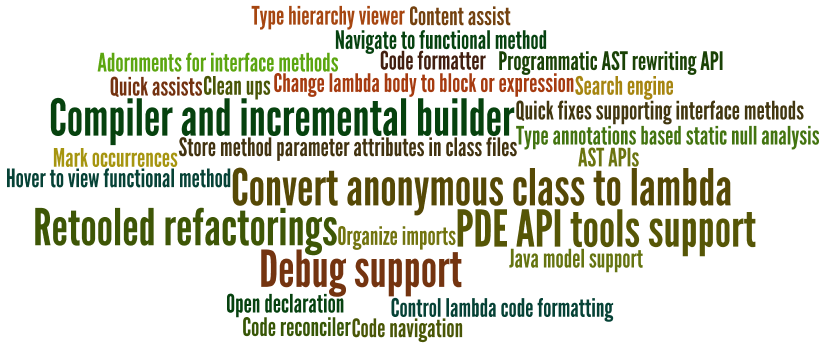Eclipse Luna: Ready for JavaTM8
Java SE 8 is the most significant expansion of the Java programming model yet and Eclipse Luna (R 4.4) has been reloaded to be ready for Java 8.
Here is a glimpse of goodies provided by Eclipse as part of the Java 8 support:
Under the hood
The Java tooling in Eclipse has its own compiler implementation which not only generates the class files, but also produces a Java document model which forms the basis for implementing a large number of tooling features.
Preparing Eclipse to be Java 8 ready involved a series of steps filled with technical and process challenges to support all the incremental updates of the Java Language Specification: the parser, compiler and indexer were evolved, the new type inference engine was developed, debugger evaluation support was added, major updates were introduced in DOM AST and Java model APIs, existing functionality was retooled to blend with the new language features and new functionality was added to make your experience with Java 8 more pleasant.
Highlights
- The Eclipse Compiler for Java (ECJ) implements all the new Java
8 language enhancements.

- Quickly change a project to be compatible with Java 8:

- Convert anonymous class creations to lambda expressions (and
back) by invoking the Quick Assists (Ctrl+1):
- Convert to lambda expression
- Convert to anonymous class creation

- Or invoke
Source > Clean Up... to migrate all your existing code to use
lambda expressions where applicable:

The functionality to migrate anonymous classes to lambda expressions has been made intelligent to make sure that only valid code is generated. It ignores the conversion where it is not possible, and it even updates the variable names to prevent name conflicts with variables from an enclosing scope. For example, the conversion is not performed if the anonymous class does not implement a functional interface, implements a functional interface with a generic abstract method, contains additional members, contains unqualified ‘this’ or ‘super’ references etc. - Change lambda expression’s body to block or expression by invoking the Quick Assists (Ctrl+1):
- The new concise syntax of lambda expressions and method
references looks nice, but it may not be so intuitive for
developers due to inferred target types, inferred parameter types,
various shorthand syntaxes for method and constructor references
etc. This is where Eclipse helps you to become more productive
while writing or understanding programs with Java 8 constructs.
- To view the method implemented by the functional interface instances, just hover on:
- To navigate to the functional method declaration, hold Ctrl, move the mouse pointer over '->' or '::', and click the hyperlink:
- You can control the formatting of lambda expressions via new Formatter options:
- You can search for method reference expressions in Java
Search by limiting the match location of methods or
constructors to method references:
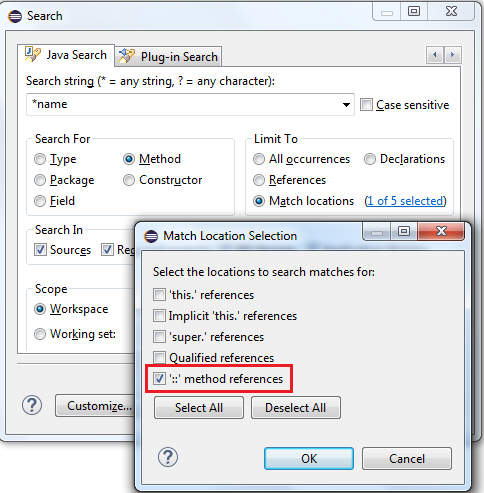
- The Type Hierarchy view and Quick Hierarchy (Ctrl+T)
(on the functional interface and its abstract method) show lambda
expressions also as implementations of the functional interface:
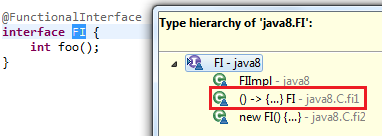
- Eclipse also provides Content Assist (Ctrl+Space) support
for method references:

- Quickly identify the abstract (A), default (D) and static (S)
methods of an interface in views like Outline, Search, Type
Hierarchy, Quick Outline / Hierarchy with the new icon adornments:

- The Java debugger supports breakpoints in lambda
expressions and evaluation or inspection in the context of
interface methods:

- JEP 118 provides the option to store information about
method parameters in class files when a programmer opts for it.
This information is then usable via reflection. In 1.8 compliance
mode, you can enable this with the new preference option:
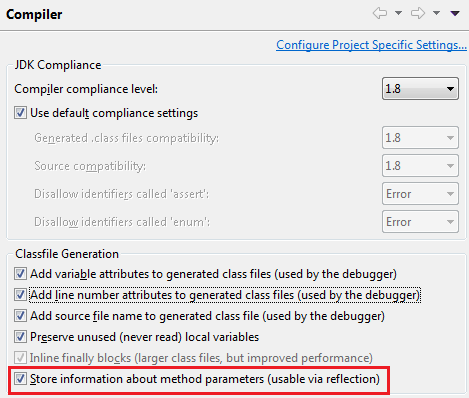
- Java tooling features like Refactorings, Source actions, Content assist (Ctrl+Space), Mark occurrences, Expand selection, Reconciler, Annotation Processor support etc. have been updated to work well with the new Java 8 features. Here is an example of the extract method support:
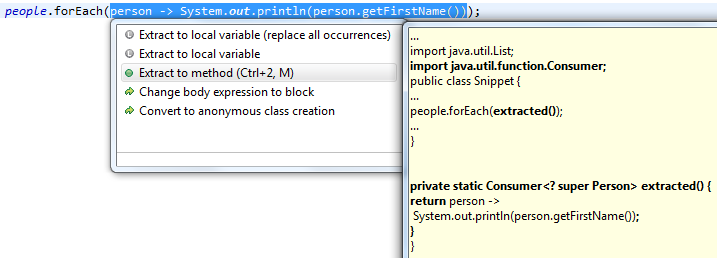
- JSR 308 introduces Type Annotations in Java 8, and
Eclipse provides the support for type
annotations based static null analysis by shipping a set of
nullness annotations as version 2.0.0 of the
org.eclipse.jdt.annotation bundle. With these annotations, compile
time type checking is possible to ensure that the specified null
constraints are not violated and all possible
NullPointerExceptions are reported (active if annotation-based
null analysis is enabled in Java Compiler > Errors/Warnings
preferences):

This supports API designers to create better interfaces with stricter rules about what can be passed to and returned from an API:

- The Eclipse Compiler for Java (with its new Java 8 type inference engine) has also been verified to successfully build major projects like JRE8, OpenJFX and Eclipse SDK (~250 projects).
About the Authors


